Sony TC-WE675, TC-WE475 User Manual

4-232-596-12 (1)
Stereo
Cassette Deck
Operating Instructions
TC-WE675
TC-WE475
© 2001 Sony Corporation
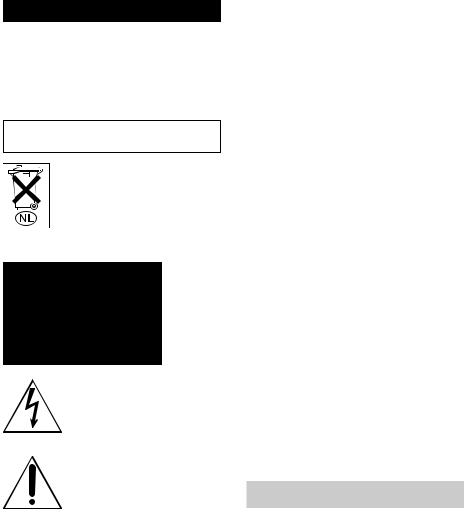
Warning
To prevent fire or shock hazard, do not expose the unit to rain or moisture.
To prevent fire, do not cover the ventilation of the apparatus with news papers, table-cloths, curtains, etc. And don’t place lighted candles on the apparatus. To prevent fire or shock hazard, do not place objects filled with liquids, such as vases, on the apparatus.
Do not install the appliance in a confined space, such as a bookcase or built-in cabinet.
Don’t throw a battery, dispose it as the injurious wastes.
NOTICE FOR THE CUSTOMERS IN THE U.S.A.
This symbol is intended to alert the user to the presence of uninsulated “dangerous voltage” within the product’s enclosure that may be of sufficient magnitude to constitute a risk of electric shock to persons.
This symbol is intended to alert the user to the presence of important operating and maintenance (servicing) instructions in the literature accompanying the appliance.
Owner’s Record
The model and serial numbers are located on the rear panel of the unit. Record the serial number in the space provided below. Refer to them whenever you call upon your Sony dealer regarding this product.
Model No. ___________
Serial No. ___________
INFORMATION
This equipment has been tested and found to comply with the limits for a Class B digital device, pursuant to Part 15 of the FCC Rules. These limits are designed to provide reasonable protection against harmful interference in a residential installation. This equipment generates, uses, and can radiate radio frequency energy and, if not installed and used in accordance with the instructions, may cause harmful interference to radio communications. However, there is no guarantee that interference will not occur in a particular installation. If this equipment does cause harmful interference to radio or television reception, which can be determined by turning the equipment off and on, the user is encouraged to try to correct the interference by one or more of the following measures:
—Reorient or relocate the receiving antenna.
—Increase the separation between the equipment and receiver.
—Connect the equipment into an outlet on a circuit different from that to which the receiver is connected.
—Consult the dealer or an experienced radio/TV technician for help.
CAUTION
You are cautioned that any changes or modification not expressly approved in this manual could void your authority to operate this equipment.
NOTICE FOR THE CUSTOMERS IN CANADA
CAUTION:
TO PREVENT ELECTRIC SHOCK, DO NOT USE THIS POLARIZED AC PLUG WITH AN EXTENSION CORD, RECEPTACLE OR OTHER OUTLET UNLESS THE BLADES CAN BE FULLY INSERTED TO PREVENT BLADE EXPOSURE.
About this manual
The instructions in this manual are for models TC-WE675 and WE475. Check your model number by looking at the rear panel of your tape deck. In this manual, the TC-WE675 is the model used for illustration purposes. Any difference in operation is clearly indicated in the text, for example, “TC-WE675 only.”
2
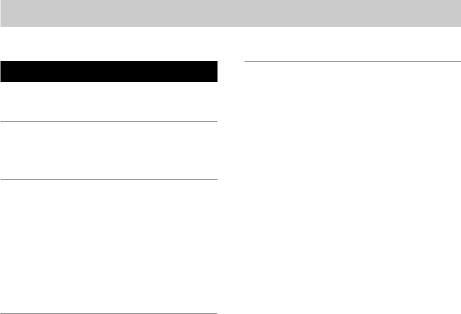
Table of Contents |
|
Parts Identification |
|
Main unit ............................................... |
4 |
Getting Started |
|
Hooking up the system .......................... |
6 |
Playing a Tape |
|
Playing a tape ........................................ |
7 |
Locating a track |
|
— Multi-AMS/Auto Play/ |
|
Memory Play ................................... |
8 |
Creating your own program |
|
— RMS Play (TC-WE675 only) ..... |
8 |
Recording on a Tape |
|
Recording on a tape ............................. |
10 |
Adjusting bias and recording level |
|
calibration automatically |
|
(TC-WE675 only) ......................... |
11 |
Adjusting the recording level |
|
automatically |
|
— Auto Rec Level ......................... |
12 |
Fading in and out — Fader .................. |
13 |
Dubbing a tape ..................................... |
14 |
Recording on both decks in succession |
|
— Relay Recording |
|
(TC-WE675 only) ......................... |
15 |
Recording the same source on both decks |
|
— Simultaneous Recording |
|
(TC-WE675 only) ......................... |
15 |
Recording your own program |
|
— RMS Dubbing |
|
(TC-WE675 only) ......................... |
16 |
Inserting a blank space during recording |
|
— Record Muting ......................... |
16 |
Using the CONTROL A1II control |
|
system ............................................ |
17 |
Additional Information |
|
Precautions .......................................... |
20 |
Troubleshooting ................................... |
22 |
Specifications ...................................... |
23 |
3

Parts Identification
The items are arranged in alphabetical order.
Refer to the pages indicated in parentheses ( ) for details.
Main unit
TC-WE675
1 2 3 4 5 6 7 8 9 0 qa qs qd qf qg qh qj
RESET |
MEMORY |
A |
COUNTER |
B |
RESET |
MEMORY |
|
|
|
||
|
|
|
|
|
|
|
|
AUTO REC LEVEL |
|||
|
|
|
|
|
|
|
|
• |
5 |
• |
|
|
|
|
|
|
|
|
|
4 |
|
6 |
|
|
|
|
|
|
|
|
|
3 |
|
7 |
|
POWER |
|
|
|
|
|
|
|
• |
|
|
|
|
|
|
|
|
|
|
|
2 |
|
|
|
|
|
|
|
|
|
|
|
• |
|
|
|
|
|
|
|
|
|
|
|
1 |
|
9 |
|
|
|
|
|
|
|
|
|
• |
|
• |
|
|
|
|
|
|
|
|
|
0 |
|
10 |
|
DIRECTION MODE |
RMS |
|
|
AUTO CAL ( START X) |
DUBBING A B |
FADER |
|
ARL |
|||
RELAY |
|
|
|
|
|
|
|
|
|||
RMS/START |
SET |
CHECK |
DISPLAY |
DECK A |
DECK B |
A+B REC |
HIGH/NORMAL |
|
|
|
|
|
– RMS + |
|
|
|
START (DECK B X) |
SYNCHRO |
|||||
m |
(AMS) |
(AMS)M |
m (AMS) |
(AMS) M |
|||||||
|
|
|
|||||||||
ON OFF |
|
|
|
|
|
|
|
|
|
|
|
CLEAR |
BACK |
FRONT |
|
|
|
|
|
|
|
||
PITCH CONTROL |
x |
|
|
|
x |
|
|
PHONES |
|
|
|
|
|
|
|
||
|
PAUSE |
REC MUTING |
REC |
DOLBY NR |
|
PAUSE |
REC MUTING |
REC |
|
OFF ON ON FILTER |
B C |
||||||
|
X |
W |
z |
|
|
X |
W |
z |
–+
•
8
•
wh |
|
|
|
|
|
wg wf wd wswa |
w; ql qk |
|
wj |
wk |
wl e; |
ea |
es |
|
|||
|
– RMS + |
|
|
|
START (DECK B X) |
|
||
m (AMS) |
(AMS)M |
m (AMS) |
(AMS) M |
|
|
|||
CLEAR |
BACK |
|
FRONT |
|
|
|
|
|
x |
|
|
|
x |
|
|
|
|
PAUSE REC MUTING |
REC |
DOLBY NR |
|
PAUSE REC MUTING |
REC |
|
||
OFF ON ON FILTER |
B C |
|
||||||
X |
W |
z |
|
|
X |
W |
z |
|
ra r; el ek ej eh eg ef ed
A + B REC ws(15) ARL qj (12)
AUTO indicator qg (10, 12) CHECK wf(9)
Deck A 3(7, 20)
DECK A wd(11) Deck B qf(10, 20) DECK B 9(11)
DIRECTION MODE 2 (7, 10) Display qs
DISPLAY 8(9) DOLBY NR ej (7, 10) FADER w; (13) HIGH/NORMAL qd(14)
MEMORY (on deck A) 7(8) MEMORY (on deck B) qa (8) PHONES jack qk
PITCH CONTROL wh(7) POWER 1 (7, 10)
REC LEVEL qh(11, 12)
RESET (on deck A) 6(8)
RESET (on deck B) q;(8)
RMS/START 4(8, 16)
SET 5(9)
SYNCHRO ql (18)
BUTTON DESCRIPTIONS
A(eject on deck B) wa (7, 10, 21)
A(eject on deck A) wg(7, 10, 21) x(stop on deck A)/CLEAR wj(7,
9, 10, 12)
M(go forward)/AMS/RMS +/m (go back)/AMS/RMS – (on deck A) wk(7, 8)
H(play on deck A)/FRONT wl (7, 8, 10, 11)
x(stop on deck B) e; (7, 10, 12) M(go forward)/AMS/m(go
back)/AMS (on deck B) ea (7, 8)
H(play on deck B) es(7, 10, 11) zREC (on deck B) ed(10)
WREC MUTING (on deck B) ef (16)
h(reverse play on deck B) eg(7, 10, 11)
XPAUSE (on deck B) eh (7, 10, 11)
zREC (on deck A) ek(10)
h(reverse play on deck A)/BACK el(7, 8, 10, 11)
WREC MUTING (on deck A) r; (16)
XPAUSE (on deck A) ra (7, 10, 11)
4
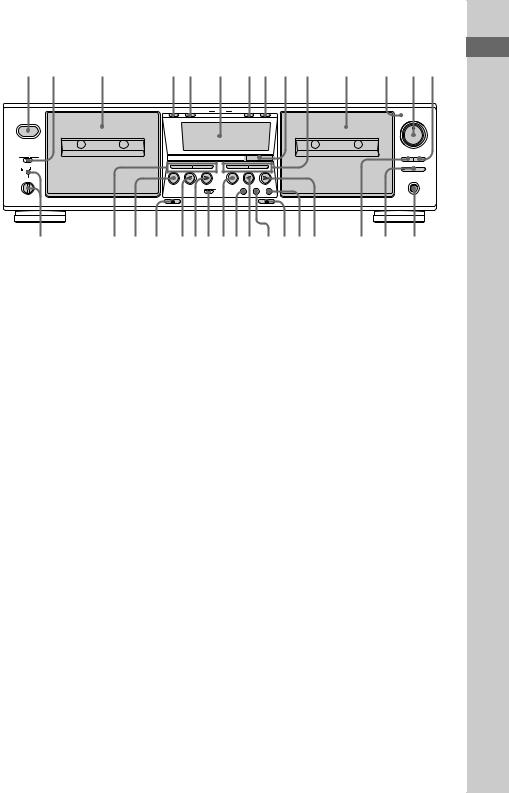
TC-WE475 |
|
|
|
|
|
|
|
|
|
1 2 |
3 |
4 5 6 7 8 9 0 qa qs qd qf |
|||||||
|
|
RESET |
MEMORY |
A |
COUNTER |
B |
RESET MEMORY |
|
|
|
|
|
|
|
|
|
|
AUTO REC LEVEL |
|
|
|
|
|
|
|
|
|
• 5 |
• |
|
|
|
|
|
|
|
|
4 |
6 |
POWER |
|
|
|
|
|
|
|
3 |
7 |
|
|
|
|
|
|
|
• |
• |
|
|
|
|
|
|
|
|
|
2 |
8 |
|
|
|
|
|
|
|
|
• |
• |
|
|
|
|
|
|
|
|
1 |
9 |
|
|
|
|
|
|
|
|
• |
• |
|
|
|
|
|
|
|
|
0 |
10 |
DIRECTION MODE |
|
|
|
|
|
|
DUBBING A B |
FADER |
ARL |
RELAY |
|
|
|
|
|
|
HIGH/NORMAL |
||
|
|
|
|
|
|
|
|
|
|
|
|
m (AMS) |
(AMS)M |
|
m (AMS) |
(AMS) M |
SYNCHRO |
||
ON OFF |
|
|
|
|
|||||
|
CLEAR |
BACK |
FRONT |
|
|
|
|
|
|
|
|
|
|
|
|
|
|||
PITCH CONTROL |
|
x |
|
|
|
x |
|
PHONES |
|
|
|
|
|
|
|
|
|||
|
|
|
|
DOLBY NR |
PAUSE REC MUTING REC |
|
|
||
|
|
|
|
OFF B |
C |
|
|
||
X W z
–+
ea |
e; |
wl wk wjwhwgwfwdws wa w;ql qk |
qj qh qg |
|||
ARL qf(12) |
|
PHONES jack qg |
|
|
||
|
|
BUTTON DESCRIPTIONS |
||||
AUTO indicator qs(10, 12) |
|
PITCH CONTROL ea(7) |
M(go forward)/AMS/m(go |
|||
Deck A 3 (7, 20) |
|
POWER 1(7, 10) |
|
|||
|
|
back)/AMS (on deck B) q;(7, 8) |
||||
Deck B qa (10, 20) |
|
REC LEVEL qd (11, 12) |
||||
|
H(play on deck B) qk (7, 10) |
|||||
DIRECTION MODE 2(7, 10) |
RESET (on deck A) 4 |
(8) |
||||
zREC (on deck B) ql(10) |
||||||
Display 6 |
|
RESET (on deck B) 7 |
(8) |
|||
|
A(eject on deck B) w;(7, 10, 21) |
|||||
DOLBY NR wg(7, 10) |
|
SYNCHRO qh(18) |
|
|||
|
|
WREC MUTING (on deck B) wa |
||||
FADER qj(13) |
|
|
|
|||
|
|
|
|
|
||
HIGH/NORMAL 9(14) |
|
(16) |
|
|
h(reverse play on deck B) ws (7, |
||
MEMORY (on deck A) 5 |
(8) |
||
10) |
|||
MEMORY (on deck B) 8 |
(8) |
||
|
XPAUSE (on deck B) wd(7) x(stop on deck B) wf(7, 10) H(play on deck A) wh(7)
h(reverse play on deck A) wj (7) A(eject on deck A) wk (7)
x(stop on deck A) wl (7)
M(go forward)/AMS /m(go back)/AMS (on deck A) e; (7, 8)
5
Identification Parts
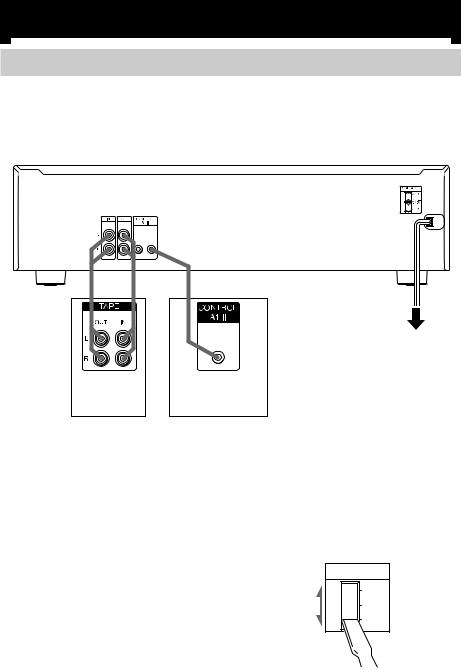
Getting Started
Hooking up the system
This section describes how to hook up the tape deck to an amplifier or a CD player equipped with CONTROL A1II connectors. Be sure to turn off the power of each component before making the connections.
Hookups
to an AC outlet
Amplifier |
CD player |
Connecting the tape deck to an amplifier
Connect the amplifier to the IN/OUT connectors using the supplied audio connecting cords.
When connecting an audio connecting cord, be sure to match the color-coded cord to the appropriate jacks on the components: Red (right) to Red and White (left) to White. Be sure to make connections firmly to avoid hum and noise.
Connecting the tape deck to a CD player equipped with CONTROL A1II connectors
For details, see “Using the CONTROL A1II control system” on page 17.
Setting the voltage selector (only on models supplied with a voltage selector)
Check that the voltage selector on the rear panel of the tape deck is set to the local power line voltage. If not, set the selector to the correct position using a screwdriver before connecting the AC power cord to an AC outlet.
VOLTAGE
220V
230 –
240V
120V
Connecting the AC power cord
Connect the AC power cord to an AC outlet.
6
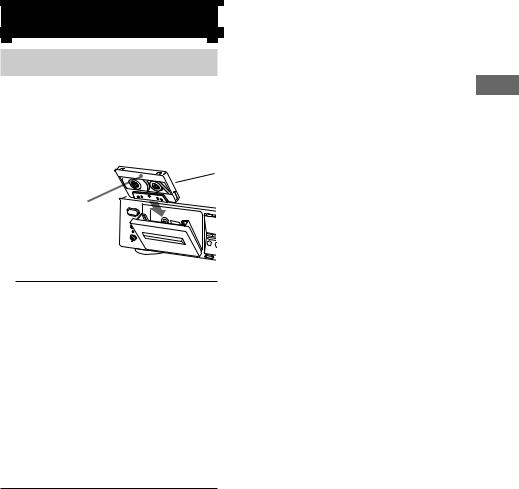
Playing a Tape
Playing a tape
1 Turn on the amplifier and select the tape deck position.
2 Press POWER, and press A fully to open the cassette holder, then load a cassette.
With the side you want to play facing you
3 Set DIRECTION MODE.
To play back |
Set to |
One side only |
g |
|
|
Both sides continuously 1) |
s |
Both decks in succession 1) |
RELAY |
1)The deck automatically stops after playing back five times.
4 Press H.
The deck starts playing. Adjust the volume on the amplifier.
Do not press POWER or Awhile the tape deck is operating. If you do so, the tape may be damaged.
To |
Press |
Stop playing |
x |
|
|
Start playback from the |
h |
reverse side |
|
|
|
Pause |
X PAUSE. Press the button |
|
again to resume play. |
|
|
Fast-forward or rewind |
M or mwhen the deck |
|
is stopped |
|
|
Take out the cassette |
A after stopping playing |
|
|
Tips
• Push in PITCH CONTROL to activate the Pitch Control function and turn the control clockwise to raise the pitch or counterclockwise to lower it.
You can adjust the pitch during playback on deck A or normal-speed dubbing (but not during RMS
play 2) or RMS dubbing 2)).
2)TC-WE675 only
•To play a tape recorded with the Dolby3) NR, set DOLBY NR to ON (TC-WE675 only) and select the same position that the tape was recorded in—B or C.
3)“Dolby”, “HX Pro”, and the double-D symbol are trademarks of Dolby Laboratories.
a Playing
Tape
7
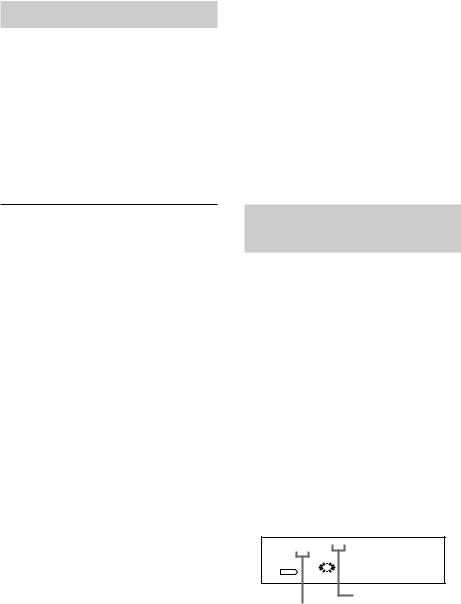
Locating a track
— Multi-AMS/Auto Play/Memory Play
You can locate the following/previous tracks within a range of 30 tracks (Multi-AMS: Automatic Music Sensor) or the beginning of a tape quickly (Auto Play). You can even locate a specific point anywhere on a tape (Memory Play).
Note
Check the direction indicator of the deck you use. When you locate a track on the reverse side (when hlights up), press the button(s) in the parentheses.
To locate |
Press |
|
The beginning of the |
M(or m) as many |
|
next or succeeding |
times as you want during |
|
tracks (Multi-AMS) |
playback. |
|
|
For example, to locate 2 |
|
|
tracks ahead, press twice. |
|
|
|
|
The beginning of the |
m(or M) once during |
|
current track |
playback. |
|
(Multi-AMS) |
|
|
|
|
|
The beginning of the |
m(or M) as many |
|
preceding tracks |
times as you want during |
|
(Multi-AMS) |
playback. |
|
|
For example, to locate 2 |
|
|
tracks behind, press three |
|
|
times. |
|
The beginning of a tape |
MEMORY repeatedly until |
|
(Auto Play) |
“M” disappears in the |
|
|
display. Then press m |
|
|
(or M) while holding |
|
|
down H(or h). |
|
A particular point on a |
MEMORY repeatedly until |
|
tape (Memory Play) |
“M” appears in the display. |
|
|
Find the point you want, |
|
|
then press RESET to reset |
|
|
the tape counter and to |
|
|
memorize the point. |
|
|
To locate the memorized |
|
|
point and start playback, |
|
|
press m (or M) while |
|
|
holding down H(or h). |
|
|
(Press m or Mto stop at |
|
|
“0000”.) |
|
|
|
|
Notes
•The Multi-AMS function may not work correctly if:
–the blank space between tracks is less than 4 seconds long.
–there is a passage of low frequencies or very low volume within a track.
–the signal strength of the left and right channels are very different.
•The Multi-AMS function is inoperative on a deck whenever the other deck is playing, recording (except during dubbing), or in pause.
•Even if DIRECTION MODE is set tos, the deck stops when the current side reaches the end during Multi-AMS operation.
•The tape counters are reset to “0000” when you turn off the tape deck.
Creating your own
program
— RMS Play
(TC-WE675 only)
By creating a program, you can play back tracks on deck A in any order that you want. The Random Music Sensor (RMS) function lets you create a program of up to 28 tracks, from the 1st to the 14th tracks on each side of the tape.
1 Press RMS/START.
“RMS” and a flashing cursor appear in the display.
2 Press h (BACK) or H(FRONT) to select the side of the tape.
h or H appears in the display.
3 Press m or M repeatedly until the track number you want appears in the display.
0 3 H
FRONT |
|
|
|
|
|
|
|
|
|
|
RMS |
1 |
2 |
3 |
4 |
5 |
6 |
7 |
8 |
9 |
10 11 12 13 14 |
BACK |
|
|
|
|
|
|
|
|
|
|
Side of the cassette
Track number
8
